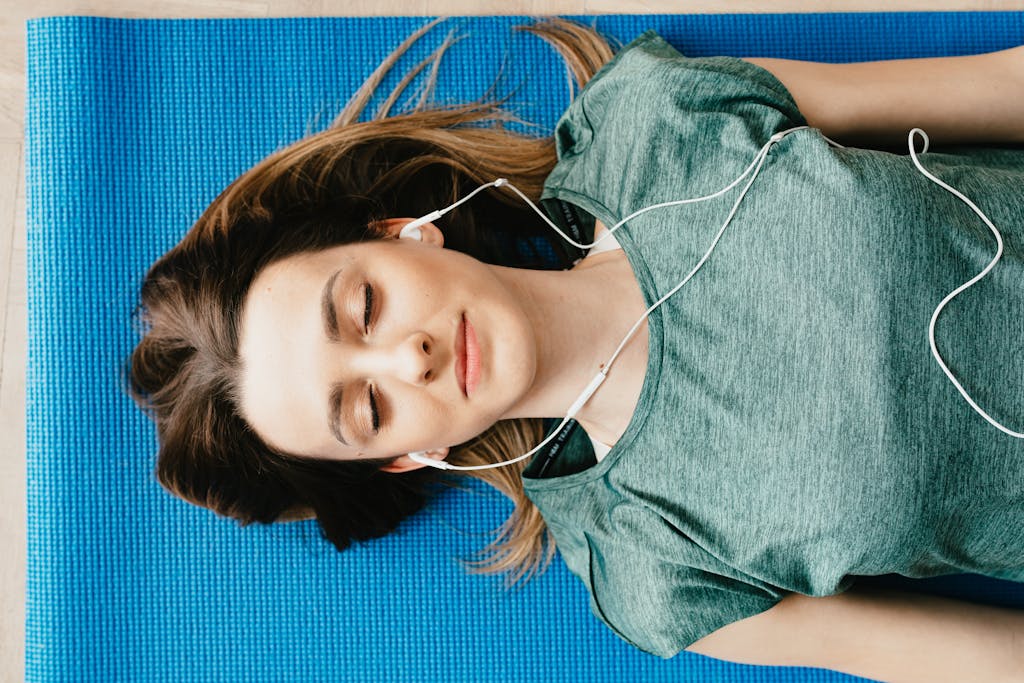FREE SHIPPING OVER $50
What Is Yoga Nidra? I Tried It for 10 Days to See If It Could Transform My Sleep
Sleep. It’s the one thing we all crave but often struggle to get enough of. For years, I’ve battled with restless nights, tossing and turning, and waking up feeling like I’d barely slept at all. Desperate for a solution, I stumbled upon Yoga Nidra, a form of guided meditation often referred to as “yogic sleep.” Intrigued, I decided to try it for 10 days to see if it could truly transform my sleep. Spoiler alert: it did. In this article, I’ll share what Yoga Nidra is, how it works, and the surprising benefits I experienced. Plus, I’ll give you a peek into a Yoga Nidra script so you can try it yourself.
What Is Yoga Nidra?

Yoga Nidra is a form of guided meditation that induces a state of deep relaxation while maintaining full consciousness. Unlike traditional meditation, where you focus on your breath or a mantra, Yoga Nidra guides you through a systematic process of body scanning, visualization, and intention-setting. It’s often called “yogic sleep” because it brings you to the threshold of sleep while keeping your mind awake and aware.
How It Works:
- You lie down in a comfortable position (Savasana).
- A guide leads you through a series of steps, including body awareness, breath focus, and visualization.
- The practice typically lasts 20-45 minutes and leaves you feeling deeply rested.
Why It’s Unique: Yoga Nidra taps into the brain’s alpha and theta waves, which are associated with relaxation and creativity. This makes it a powerful tool for reducing stress, improving sleep, and enhancing overall well-being.
My 10-Day Yoga Nidra Experiment
I committed to practicing Yoga Nidra for sleep every night for 10 days. Here’s how it went:
Day 1-3: The Adjustment Phase
- The first few sessions felt strange. Lying still for 20 minutes while listening to a Yoga Nidra script was harder than I expected. My mind wandered, and I struggled to stay focused.
- Despite this, I noticed a sense of calm afterward. Falling asleep felt easier, but I still woke up a few times during the night.
Day 4-7: The Turning Point
- By day four, I started to look forward to my nightly practice. The Yoga Nidra meditation became a comforting ritual.
- I began to fall asleep faster and stay asleep longer. My mind felt quieter, and I woke up feeling more refreshed.
Day 8-10: The Transformation
- By the end of the experiment, I was hooked. My sleep quality had improved dramatically. I no longer woke up groggy or restless.
- Beyond sleep, I noticed other benefits: reduced stress, better focus during the day, and a general sense of calm.
The Benefits of Yoga Nidra
My 10-day experiment revealed just how powerful Yoga Nidra benefits can be. Here’s what I experienced—and what science backs up:
1. Improved Sleep Quality
- Yoga Nidra helps calm the nervous system, making it easier to fall asleep and stay asleep.
- Studies show it can reduce insomnia and improve sleep patterns.
2. Reduced Stress and Anxiety
- The practice activates the parasympathetic nervous system, which counteracts the body’s stress response.
- Research suggests it can lower cortisol levels and promote relaxation.
3. Enhanced Mental Clarity
- By quieting the mind, Yoga Nidra improves focus and cognitive function.
- Many people report feeling more creative and productive after regular practice.
4. Emotional Healing
- The practice often includes setting an intention (Sankalpa), which can help reprogram negative thought patterns.
- It’s been used to support trauma recovery and emotional well-being.
5. Physical Relaxation
- The body scan component releases tension and promotes deep physical relaxation.
- It’s a great way to unwind after a long day or intense workout.
How to Practice Yoga Nidra for Sleep
Ready to give it a try? Here’s a simple Yoga Nidra script to get you started:
- Set Up: Lie down in a comfortable position, preferably on your back. Use a pillow or blanket if needed.
- Intention Setting: Set a positive intention (Sankalpa) for your practice. For example, “I am calm and rested.”
- Body Scan: Focus on each part of your body, starting with your toes and moving upward. Relax each area as you go.
- Breath Awareness: Notice your natural breath without trying to change it. Feel the rise and fall of your chest.
- Visualization: Imagine a peaceful scene, like a beach or forest. Engage all your senses in the visualization.
- Return to Awareness: Slowly bring your attention back to your body and surroundings. Wiggle your fingers and toes before opening your eyes.
Pro Tip: Use a guided Yoga Nidra for sleep recording if you’re new to the practice. Apps like Insight Timer and YouTube have plenty of options.
Why Yoga Nidra Works for Sleep
So, why is Yoga Nidra meditation so effective for sleep? Here’s the science behind it:
- Activates the Relaxation Response: Yoga Nidra shifts your body into a parasympathetic state, which is essential for rest and recovery.
- Reduces Mental Chatter: The guided process quiets the mind, making it easier to let go of stress and worries.
- Promotes Theta Brainwaves: These brainwaves are associated with deep relaxation and creativity, helping you drift off more easily.
- Encourages Mindfulness: By focusing on the present moment, Yoga Nidra helps break the cycle of overthinking that often disrupts sleep.
Tips for a Successful Yoga Nidra Practice
To get the most out of your Yoga Nidra for sleep practice, keep these tips in mind:
- Create a Calm Environment: Dim the lights, play soft music, and eliminate distractions.
- Be Consistent: Practice at the same time each day to build a routine.
- Stay Open-Minded: Don’t worry if your mind wanders—it’s part of the process.
- Use a Guided Session: A good Yoga Nidra script can help you stay focused and relaxed.
- Be Patient: Like any new habit, it takes time to see results. Stick with it!
Final Thoughts
What is Yoga Nidra? It’s a powerful tool for relaxation, sleep, and overall well-being. After just 10 days of practicing Yoga Nidra for sleep, I noticed a significant improvement in my sleep quality, stress levels, and mental clarity. Whether you’re struggling with insomnia, stress, or just want to feel more rested, Yoga Nidra is worth a try. So, grab a mat, find a quiet space, and let this ancient practice work its magic. Sweet dreams!
Related Articles
- Chair Yoga for Seniors: Free 28-Day Plan to Boost Flexibility and Wellness
- Chair Yoga That’s Actually Worth Your Time (10 Minutes to Strength and Mobility)
- How This One Tool Revolutionized My Yoga Routine and Boosted My Mobility
- Two Weeks of This Yoga Pose Changed My Posture – You Won’t Believe the Results!
- Soothe Your Aching Back: 5 Yoga Poses You Need to Try Today



